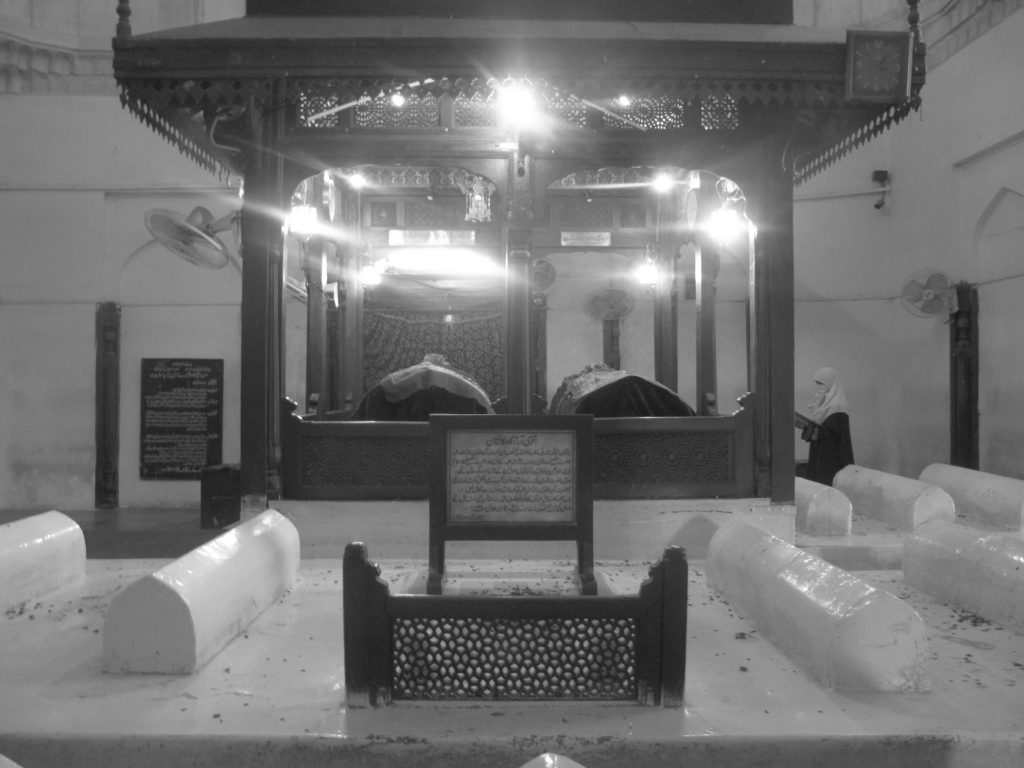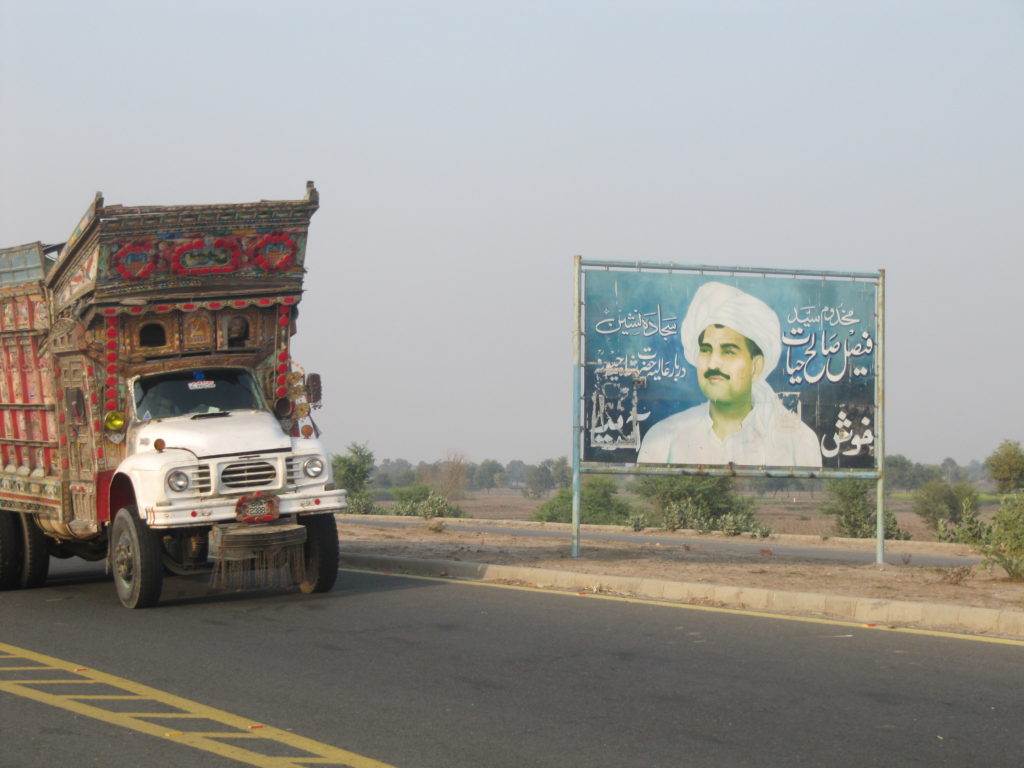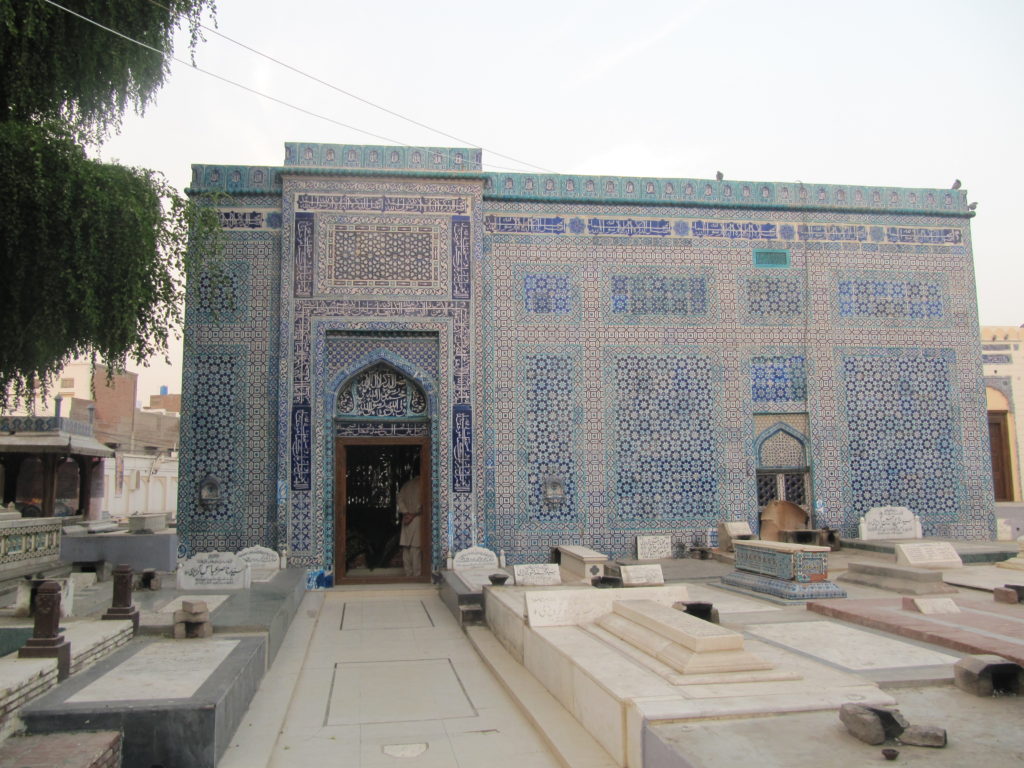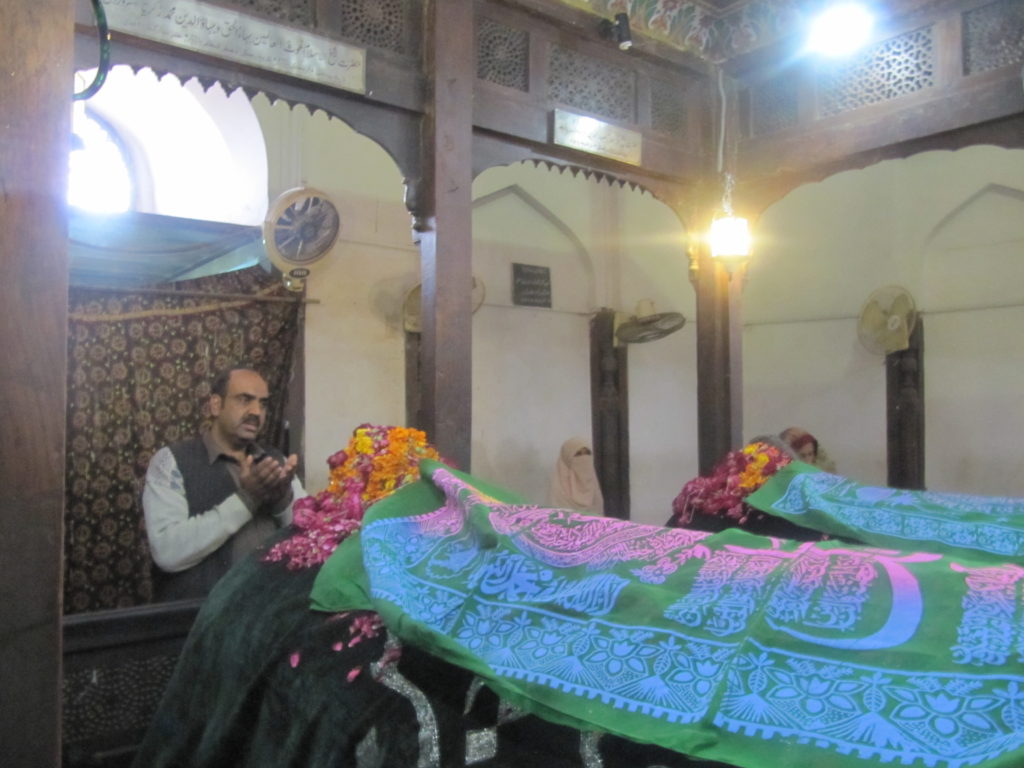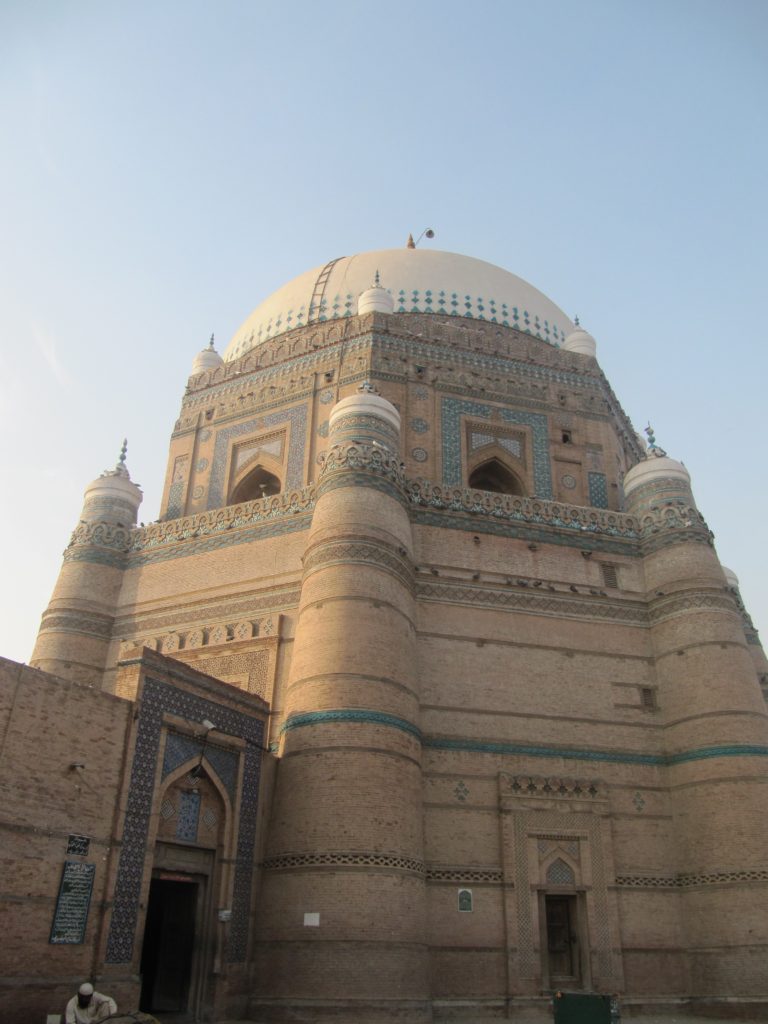By Umar Farooq
The scene that greets the devotee upon entering the final resting place of Shah Jewna leaves little doubt as to what is expected of them in the world outside.
The shrine—an expansive complex of marble buildings that is expanded every year—rises out of a landscape of dusty fields of cotton and fruit orchards pockmarked by brick kilns and dilapidated shops, the most important landmark for miles around. A dirt road leads to the shrine, some 125 miles west of the city of Lahore, in Punjab province. Hawkers line the road, calling out to the visitor to purchase sweets and flowers to offer Shah Jewna. A three story high arch covered in blue tiles leads to a stairway landing on a clean, white marble courtyard. On one end is a mosque, empty. On another, fifteen cells housing pilgrims that have come to visit the shrine for the traditional nine-day period, sweeping the floors and helping to cook the langar, the free meal offered to impoverished visitors.
The pilgrims seek the intercession of Shah Jewna, hoping the help of an awliyah—or “friend of Allah” –can increase the chances of their prayers being answered.
Shah Jewna, whose grandfather migrated to the region from Bukhara in the 15th century, was a descendant of the Prophet Muhammad. Shrines like the one devoted to him litter the landscape throughout Pakistan, with the most prominent ones dating from the 11th to 16th centuries. They house the remains of mystics and ascetics that travelled to the region when Islam was still taking root. Their followers grew as stories of their miraculous powers spread, and their generosity and charity towards the poor helped convert many local Hindus to Islam. Shah Jewna, for example, is credited with bringing a boy who had been stabbed in the chest back to life.
Visitors to the Shah Jewna shrine are confronted by a series of banners bearing the image of Makhdoom Syed Faisal Saleh Hayat, the direct descendant of Shah Jewna. The title makhdoom signifies Hayat’s status as a descendant and caretaker of a shrine. “May Allah bestow peace upon Muhammad and on the family of Muhammad,” says one banner in Arabic, recalling part of a rote that every Muslim must recite during five daily prayers. It’s a reminder of the special status given to the Prophet Muhammad’s family, whose descendants in this part of the world carry the title syed.
Another banner asks devotees to vote for Hayat, a remnant from elections held in May this year, when he ran for Parliament for the two districts near the shrine.
In Pakistan, the descendants of saints like Shah Jewna have played an important role in politics for centuries. They have historically commanded the devotion of hundreds of thousands of followers who looked to them for guidance in all spheres of life. Prime Ministers, Presidents, and numerous legislators have been elected into office because of the influence they wield as spiritual guides for millions of Pakistanis.
But things are changing in Pakistan, which is experiencing rising urbanization and an Islamic revival that is gradually moving Muslims away from the Sufi shrines that used to dominate rural life. Increasingly, urbanized Muslims in Pakistan are looking for a direct path to Allah, one that does not involve the intercession of saints. As a result, the descendants of those saints, or those that control shrines housing those saints, exert less and less influence.
The makhdooms have tried to supplant the decline in religious devotees with patronage, granting government resources to those voters that are loyal to them. But in areas where people are no longer dependent on the patronage of landowning makhdooms like Hayat, more and more Pakistanis are voting based on the candidate’s record and platform instead of their pedigree. And voters are less likely to overlook allegations of corruption against a makhdoom.
“I’ve always voted for him [Hayat], for the last 30 years,” says a scrap dealer on the main road of Shah Jewna and a regular visitor to the shrine. “Everyone here votes for him.” Hayat is the sajjada-nashin, the head, of Shah Jewna’s congregation, millions of people that credit the saint for converting their ancestors to Islam. On the death anniversary of Shah Jewna – called his urs, or marriage with Allah—hundreds of thousands will show up to pay their respects at the shrine.
Despite repeatedly switching political parties, Hayat has won the area’s National Assembly seat in almost every electoral contest since 1977. The years he has lost, his cousin Syeda Abida Hussain, also a descendant of Shah Jewna, has won instead. Hayat served as a Federal Minister five times, including as the Minister of Interior under President Pervez Musharraf in 2002, when he was accused of doling out thousands of government jobs to his constituents in return for their votes.
“He hasn’t done anything as noteworthy as the bridge,” says Khanam Ahmed, who makes bricks at a kiln near the shrine. Until 2010, the town of Shah Jewna was connected to the nearby city of Jhang by a single, rickety, century-old bridge that served pedestrians, cars, and trains. Hayat had a new bridge built, and giant billboards have been erected along the road leading into town to make sure no one forgets it. “We have always voted for one of the two families,” says Sarfaraz Amir, another brick maker, referring to Hayat and Hussain’s families. “Both have never done much work. They know they will always get votes.”
Shah Jewna only has basic primary-level schools, which are so far apart many parents simply don’t send their kids. Many homes lack electricity, and no one has access to natural gas for heating or cooking. “We only see him [Hayat] during elections,” says Amir. Like many of the politicians in this part of Pakistan, Hayat lives in Islamabad, and only returns to campaign for elections or partake in the annual urs.
Despite Hayat’s wholesale neglect of his constituency, almost all the residents of the town of Shah Jewna will continue to vote for him or his family. At first glance, it might seem like a simple case of religious devotion, but as Hayat’s record on development shows, many voters choose him because they need him to get even the most basic infrastructure. With no local government, development lies entirely in the hands of provincial and national legislators like Hayat, who receive $200,000 each term to spend on their constituency.
But Hayat lost the 2013 elections. Redistricting just before the elections changed the usual constituency, introducing a new, more urbanized voting block outside Shah Jewna into the electorate and making it possible for a third candidate, unconnected to the shrine, to win by a narrow margin.
The example of the Shah Jewna shrine bears an important lesson for examining the power of Sufi shrines in Pakistan: veneration is not a guarantee of victory. Even makhdooms must supplant power with patronage, because their constituencies are changing, and including those that are no longer willing to blindly hand their spiritual masters their votes.
The city of Multan, in southern Punjab, is called the City of Saints because of the numerous famous shrines it houses. It’s a dusty and ancient abode, with luxurious Land Cruisers carefully making their way through hoards of donkey-drawn carts. When Alexander the Great arrived in Multan in 326 BC, it was already a bustling city, surrounded by massive fortified walls. It was the first major city to come under Muslim rule in South Asia, falling to Arab armies led by Muhammad bin Qasim in 712 AD, and remaining largely under Muslim rule until 1818, when the Sikh Maharaja Ranjit Singh took over Multan and the Punjab.
Between the 12th and 16th centuries, Multan attracted a large numbers of Sufi ascetics whose shrines continue to shape the political landscape of Pakistan.
Beginning with the Mughul Empire in the 16th century and throughout Sikh rule in the 19th century, the makhdooms and pirs of Multan were given tracts of land in exchange for political support. After 1848, the British accelerated this process, handing out huge landholdings in exchange for their support in putting down rebellions over the next few decades.
It was a carefully calculated move on the part of the British, which ended up empowering a handful of makhdoom families that still dominate politics in southern Punjab. “Practically every Muhammadan in the district has his pir … in most cases a Syad, Koreshi, or Khagga,” explains the 1923 Gazetteer of the Multan District, referring to three families that continue to dominate politics in the region today. When a Muslim and Hindu-led rebellion broke out in 1857, the same makhdooms “rendered valuable assistance to Government” and in return “ received suitable rewards.”
Locals still tell tales of the British doling out huge tracts of land to the families. One folk tale explains how the British would simply let a horse run until it collapsed form exhaustion, and hand the entire length it had traversed to the makhdooms. The loyalists were given key administrative jobs, seats in District Councils or made Magistrates, paving the way for their future dominance of politics. In 1900, in an effort to undercut the emerging power of urban capitalists opposed to their rule, the British passed the Punjab Alienation of Land Act, explicitly defining a set of “agricultural tribes” that included Sufi shrine caretakers, and barring others from obtaining land in rural areas. The shrine leadership, which traditionally relied on its religious prestige, now found itself in perpetual ownership of large tracts of farmland.
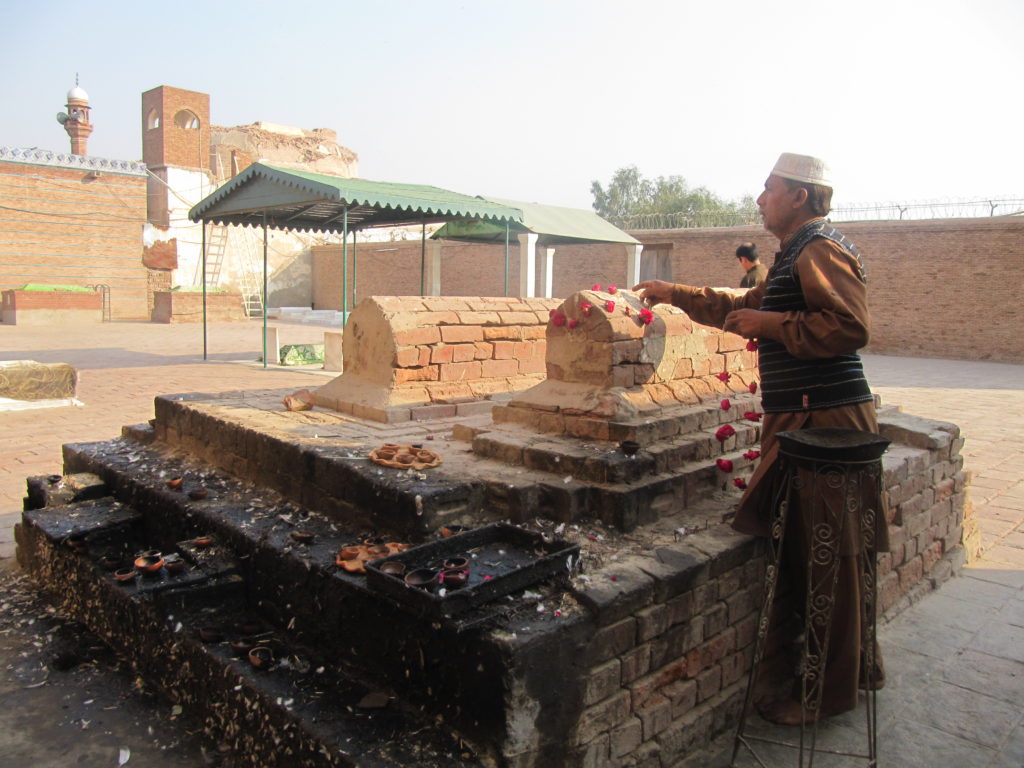
A man puts fresh garlands on the grave of a makhdoom at the shrine of Bahauddin Zakariya in the Multan fort. Photo: Umar Farooq.
The most important shrines in Multan are situated around the ancient city’s fort. The tombs of two of Pakistan’s most revered saints, Bahauddin Zakariya (died 1267) and Shah Rukne Alam (died 1335), sit on a hill inside the fort, rising high above the perpetual haze that blankets the city. The beautiful octagonal buildings—topped with domes and massive spires—are usually crowded with thousands of worshipers from all over Pakistan. Traditionally, the pilgrims make their way to the shrines by walking on bare feet, in some cases from hundreds of kilometers away. For many, this is the only pilgrimage they will ever be able to make—the cost of going to Mecca for the Hajj being unimaginably out of reach.
Inside Bahauddin Zakariya’s tomb, scores of mounds covered in a single layer of white plaster mark the final resting places of his earliest, closest followers, his murids. Just outside the building are scores more graves, shrines in the making, to his makhdooms, the unbroken line of descendants that look after his legacy.
Visitors light candles to symbolize their prayers, leaving them on the tombs. Some sprinkle the graves with rose petals, and others tie pieces of string to the building’s window screens. The strings are mannats, reminders of an oath sworn to the saint that must be fulfilled if the visitor’s prayer is answered. When the oath is fulfilled, the visitor will return to the shrine and remove the mannat.
In an open space set apart from the ancient graves, a gazebo houses the graves of the last generations of makhdooms, the father and grandfather of Shah Mehmood Qureshi, the current makhdoom and the area’s representative in Pakistan’s National Assembly—the Qureshis are just one of a number of prominent families connected to shrines in the area. Qureshi, a Cambridge-educated farmer, previously served as the Foreign Minister of Pakistan, and his late father served as the governor of Punjab. He’s also the makhdoom of the nearby shrine of Shah Rukne Alam, the grandson of Bahauddin Zakariya.
Another nearby shrine is under the care of Yusuf Raza Gilani, who served as Pakistan’s Prime Minister between 2008 and 2012. Prime Minister Gilani is the makhdoom of the shrine of Syed Musa Pak Gilani (died 1592), who links his family to that of Abdul Qadir Gilani, a 12th century mystic that most Sufi orders the world over trace their origin to.
But not every shrine in Multan has played a role in politics.
The shrine of Shah Shamsuddin Sabzwari (died 1276) lies outside the Multan fort, and is in need of extensive repair. Historically, the shrine’s caretakers have refused to take any part in politics, which helps explain the financial straits it is in.
“The makhdooms have lots of influence, wherever people are ignorant, they have followers,” says Makhdoom Syed Zahid Hussain Shamsi, the shrine’s caretaker and a direct descendant of Shah Shamsuddin. Shamsi is a lawyer, and claims the other shrines—particularly that of Syed Musa Pak Gilani—divert funds meant to restore all the city’s shrines.
Yusuf Raza Gilani was removed from the post of Prime Minister in 2012, after refusing to re-open corruption cases against then President Asif Ali Zardari. Last year, Pakistani investigators decided to indict him for a series of corruption cases. During his time as Prime Minister, Gilani diverted more than $200 million to development projects in Multan, building half a dozen flyovers and an expressway, and a new bridge connecting a largely isolated community to the west of the city.
Despite their religious following and attempts at patronage, the Gilanis lost almost every contest they were involved in this year’s elections (Yusuf Raza Gilani himself was disqualified from ever running for office by the Supreme Court.). The loss can partly be attributed to the fact that the family no longer controls enough land to form a single voting block – much of their historical farm land has been divided among children.
But Pakistanis are also adopting higher expectations for their leadership, and the makhdooms are not immune to this. The party the Gilanis were affiliated with, the Pakistan People’s Party, was handed a resounding defeat nationally because of allegations of corruption against its leadership. Both of Yusuf Raza Gilani’s sons lost, even though they were contesting elections from traditional family seats. His nephew, Pir Ali Baba, was also roundly defeated in the town of Sandhilianwali, in central Punjab, despite having followers there that number in the several hundred thousands.
Whatever edge the Gilanis had because of their lineage was overshadowed by their affiliation with the Pakistan People’s Party and its reputation for corrupt leadership.
Shah Mehmood Qureshi opted to join a new party, the Pakistan Tehrike e Insaaf, which won a sizable victory in this year’s elections based on an aggressively anti-corruption platform.
Pakistan’s 342-member National Assembly includes six makhdooms, descendants of Sufi saints like Hayat that head large congregations. There are also five pirs, leaders of shrines that are not direct descendants of saints, but who still command hundreds of thousands of followers. Finally, there are 17 syeds who claim descent from the Prophet Muhammad, but may not lead religious congregations.
The defeat of the Gilanis and Syed Faisal Saleh Hayat due to their image as corrupt politicians is an indication of the declining power wielded by Sufi leaders. But there is another reason behind the diminishing influence of the shrines and their caretakers.
Pakistan is urbanizing rapidly – nearly 40% of people live in cities today, twice the percentage in 1951 – and more and more people are being influenced by Islamic revival movements of the last century that have shunned the veneration of shrines, likening it to the worship of those buried there.
Increasingly cosmopolitan lifestyles have moved Muslims away from shrines. Individuals that used to look towards a shrine as a spiritual center in their rural lives, may now view Sufism as archaic.
Shaukat Ijaz, a real estate broker from Haripur migrated to Islamabad more than a decade ago looking for work. Initially, he spent much of his spare time at one of the city’s most famous shrines, Golra Sharif, the burial place of Pir Meher Ali Shah, a saint who lived during the 19th century. Ijaz studied the Quran directly under the saint’s grandson , and today the sight of throngs of devotees kissing the grave of his teacher makes him visibly uncomfortable.
A few weeks before last year’s elections, the current sajjada-nashin of Golra Sharif, Pir Jalaluddin, told his followers to support the Pakistan Tehrik e Insaaf party.
After congregational prayers at the shrine on a recent Friday evening, thousands of men and women formed lines that stretch for more than a hundred yards, waiting to meet Pir Jalaluddin and ask for his advice. Guidance will be given in every arena, from how to atone for a sin, to who to marry and where to invest money.
Ijaz maintains his distance from the pir. After spending a few years at the shrine, Ijaz says he joined the Tablighi Jamaat, a revivalist Islamist movement that promotes individual enlightenment over the veneration of saints. Members of the Tablighi Jamaat form small, autonomous groups that visit communities of Muslims, usually in far flung places, even in other countries, in an effort to revive Islam at the individual level. The movement advocates self-betterment and introspection, and a religious adherence to obligatory worship like the five daily prayers. With the Tableeghi Jamaat, Ijaz will go on pilgrimages that might last up to four months, but he will not head for shrines, he will head for mosques, where he will spend his spare time in meditation on his own, or in discussions with fellow travelers.
Like millions of other rapidly urbanizing Pakistanis, Ijaz has circumscribed the role of the shrine in his spiritual life. He regularly visits the shrine, but he does not seek any blessings from the saint’s being. When it comes to voting, he says he would never think of voting according to the pir’s wishes. In fact, in this election, he did not follow the sajjada-nashin’s advice, and voted for a different party altogether.
Along with the anti-corruption stance of voters, reformist attitudes toward Sufism like Ijaz’s could spell the end of shrines in Pakistan’s politics altogether.
Umar Farooq is a freelance journalist whose work has appeared in the Christian Science Monitor, the Wall Street Journal, and the Globe and Mail. He tweets @UmarFarooq_
With support from the Henry R. Luce Initiative on Religion and International Affairs.


